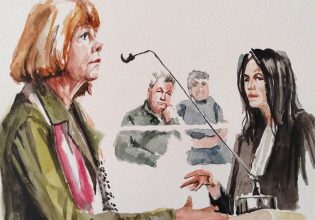Neither history nor the Left has ended
Many are rushing to announce the Left’s demise
*The first of 4 chapters on what the Left is today
I am noticing a narrative developing lately, according to which the working classes worldwide have stopped being inspired by what we defined as the ideals of the Left and are turning to right-wing or even authoritarian ideas. Accordingly, while in the previous decade it was seen how «radical Left» versions could have more resonance, amid conditions of economic and social crisis, now only openly right-wing positions, such as those of Sir Keir Starmer, the Labour leader in Britain, who purged almost every left-wing voice, beginning with his predecessor Jeremy Corbyn, seem to radiate electoral hope. I have no objection to admitting that some of the phenomena identified by those who embrace this narrative of an end of the Left are real.
Indeed, in many countries we see the Left as losing appeal to working class people and the poor, who are instead attracted to the extreme right or various variations of the right. From Trump and a section of poor whites, to Marine Le Pen’s appeal to traditional working classes, examples abound.
And, indeed, there are several signs of political failure of the Left, starting of course with the very negative effects of the capitulation of Syriza party in 2015. However, I think that these phenomena are not sufficient to answer whether we are really living through the «end of the Left».
Instead, they show the failure of a certain version of the Left.
Because what we have come to describe as the «Left», for more than two centuries, is not just an ideology, not even a worldview. It is much more, a historical dynamic that developed because there were – and are – social strata that felt oppressed and wronged and sought ways to clash with autocracy first – capitalism and colonialism later. These demands and these needs were represented by the various political currents that we have since defined as the Left. Obviously, these political currents went through various periods of crisis and clearly, especially the collapse of the Soviet bloc increased this sense of crisis. All too often, such currents ended up breaking off with the very segments of society they were supposed to represent. Sometimes, they mutated into the exact opposite direction.
However, this does not mean that the needs of the lower socio-economic classes, their demands, concerns, dreams were met. Because we’re actually dealing with two issues and it’s almost ridiculous to confuse them. One concerns whether the popular classes, workers and the middle class are satisfied with the present treaty. That is, if they like living in a world of wealth inequality, essentially authoritarian governance, and ongoing climate catastrophe. The other is to see if they are represented by variations of the Left that exist today, by which I mean existing formations and parties.
Because it’s obvious that the answer to the first question is that the majority of people are far from satisfied with the state of things. They feel that they work too much, that their earnings do not cover the cost of living, that their work does not give them much satisfaction, that even more negative effects are forecast from climate change, which can render entire areas of the planet uninhabitable. They are also concerned over being more easily targeted by repressive forces, and that they can count on much less government aid in an «emergency».
This means that even if we still provide an answer to the second question, that yes, much of the existing Left is inadequate vis-a-vis needs of the popular classes, this cannot mean that the «end of the Left» has arrived.
A more correct reading is that the need for a new Left is emerging.
Moreover, even if we admit to a crisis of political formations on the Left, this does not mean that within society, amid movements, in think tanks, universities, etc. that there is no discourse, analysis and demands being produced, which could fuel a new Left.
Correspondingly, the finding that there are parts of the popular classes that turn to the extreme right, one of the most important problems we face, has much more to do with the removal of the political Left from these layers than with the fact that societies no longer need the Left.
To put it another way, those who are now rushing to herald the end of the Left, or the end of the Left’s relationship with society, are really just projecting their own wish. That is, their fantasy of a world where there will be no objections and resistance to the way capitalism or what we call «globalization» evolves. A world where workers will have no demands from employers, citizens from the state, young people from seniors, societies from the international economic system, peoples from all those who insist on starting wars, the poor and the downtrodden from those who they raise fences to hope.
Except that this world doesn’t exist.
In the real world, need is abundant and hope is lacking. And there is violence, and exploitation, and oppression, and sexism, and racism, and ecological destruction. This means that there is still a need in the world for the Left. Whether we call it that or not. And if it doesn’t exist, let’s see how we can create it.
PS. “a map of the world that does not include Utopia is not worth even glancing at, for it leaves out the one country at which Humanity is always landing. And when Humanity lands there, it looks out, and seeing a better country, sets sail. Progress is the realisation of utopias.”
Oscar Wilde
- Τα ζώδια σήμερα: Γλύκανε μωρέ λίγο, μην είσαι σαν κακό χρόνο να’χεις
- Φούσκωμα μετά το φαγητό, αυτή η γιορτινή μάστιγα
- Χριστουγεννιάτικα πάρτι: Οδηγός επιβίωσης στις βαρετές συγκεντρώσεις
- Η καλύτερή μου φίλη εδώ και 40 χρόνια έχει μια στρεβλή εντύπωση για μένα – Θα το λύσουμε;
- Economist: Οι εργαζόμενοι αγαπούν τον Τραμπ, τα συνδικάτα πρέπει να τον φοβούνται
- Φάρμακα για απώλεια βάρους: Γιατί στέλνουν τους Αμερικανούς στον γιατρό










